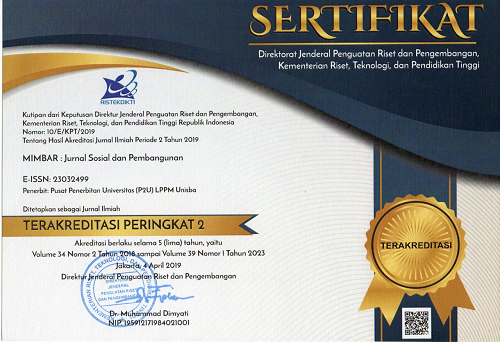Strategies to De-Escalate the Conflict of Yogyakarta International Airport Construction
Abstract
The policy on the construction of Yogyakarta International Airport was responded with a rejection by the public that ended in quite a prolonged conflict. The conflict occurred because of the competing interests between the interests of the government to build an airport and the interests of the residents to stay in that location. In seven years since 2011, the conflict had de-escalated quite significantly from 2018 to 2019. This research analyzes strategies for conflict de-escalation, in which negotiation and mediation become its operating method. Researchers used a qualitative approach to extract data from actors involved in the conflict, namely the community living in the three villages most affected by the airport construction, representatives from Angkasa Pura I as the airport management authority, and representatives from the Local Government. In-depth interviews were conducted with ten key informants determined by purposive technique. The result of this research shows that the de-escalation of the conflict was managed to achieve through a persuasive approach that involved all of those concerned.
Keywords
Full Text:
PDFReferences
Alazemi, M., & Mohiuddin, A. (2019). Construction Project in Kuwait International Airport Cargo City: Issue of Conflict Management. International Journal of Engineering Materials and Manufacture, 4(2), 59–65. https://doi.org/10.26776/ijemm.04.02.2019.03
Anderson, L. L., & Polkinghorn, B. (2008). Managing conflict in construction megaprojects: Leadership and third-party principles. Conflict Resolution Quarterly, 26(2), 167–198. https://doi.org/10.1002/crq.229
Badan Perencanaan Pembangunan Nasional Republik Indonesia. (2014). Rencana Pembangunan Infrastruktur 2015-2019 dan Alokasi APBN 2015.
Bercovitch, J. (1983). Conflict and Conflict Management in Organizations: A Framework for Analysis. Hong Kong Journal of Public Administration, 5(2), 104–123. https://doi.org/10.1080/02529165.1983.10800140
Boloukian, R., & Siegmann, J. (2016). Urban Logistics; a Key for the Airport-Centric Development – A Review on Development Approaches and the Role of Urban Logistics in Comprehensive Airport-Centric Planning. Transportation Research Procedia, 12, 800–811. https://doi.org/https://doi.org/10.1016/j.trpro.2016.02.033
Brockman, J. L. (2014). Interpersonal Conflict in Construction: Cost, Cause, and Consequence. Journal of Construction Engineering and Management, 140(2), 04013050. https://doi.org/10.1061/(asce)co.1943-7862.0000805
Brown, G., & Raymond, C. M. (2014). Methods for identifying land use conflict potential using participatory mapping. Landscape and Urban Planning, 122, 196–208. https://doi.org/https://doi.org/10.1016/j.landurbplan.2013.11.007
Čokorilo, O. (2016). Environmental Issues for Aircraft Operations at Airports. Transportation Research Procedia, 14, 3713–3720. https://doi.org/https://doi.org/10.1016/j.trpro.2016.05.491
da Silva, B. A. C., Santos, G. S., & Gomes, R. de A. (2020). Land use policy in the vicinity of airports: Analysis and lessons learned from the Brazilian situation. Land Use Policy, 90, 104314. https://doi.org/https://doi.org/10.1016/j.landusepol.2019.104314
Eren, F. (2019). Top government hands-on megaproject management: the case of Istanbul’s grand airport. International Journal of Managing Projects in Business, 12(3). https://doi.org/10.1108/IJMPB-02-2018-0020
Feldhoff, T. (2002). Japan’s regional airports: conflicting national, regional and local interests. Journal of Transport Geography, 10(3), 165–175. https://doi.org/https://doi.org/10.1016/S0966-6923(02)00009-1
Fitriantoro, M. I. (2020). Drivers of Conflict in Urban Infrastructure: Case Study of the New Yogyakarta Airport. Jurnal Politik, 6(1). https://doi.org/10.7454/jp.v6i1.214
Haekal, L. (2020). Ekspansi Geografis dan Perampasan Lahan: Sisi Lain Pembangunan Yogyakarta International Airport. Politika: Jurnal Ilmu Politik, 11(1). https://doi.org/10.14710/politika.11.1.2020.31-52
Herry, M. (2012). Kearifan Lokal dalam menyelesaikan Konflik Agraria. UIN-Maliki Press.
Iswan Kaputra, & Prathiwi Widyatmi Putri. (2020). The Precarity of Peri-urban Resistance: A Resistance to the Forced Eviction of Pasar VI Village and the Development of Kualanamu International Airport, North Sumatera. PCD Journal, 8(1). https://doi.org/10.22146/pcd.v8i1.419
Jia, G., Yang, F., Wang, G., Hong, B., & You, R. (2011). A study of megaproject from a perspective of social conflict theory. International Journal of Project Management, 29(7), 817–827. https://doi.org/10.1016/j.ijproman.2011.04.004
Kementerian PPN/Bappenas. (n.d.). Master Plan Percepatan dan Perluasan Pembangunan Ekonomi Indonesia (MP3EI) 2011-2025.
Lee, C., Won, J. W., Jang, W., Jung, W., Han, S. H., & Kwak, Y. H. (2017). Social conflict management framework for project viability: Case studies from Korean megaprojects. International Journal of Project Management, 35(8), 1683–1696. https://doi.org/https://doi.org/10.1016/j.ijproman.2017.07.011
Li, T. H. Y., Ng, S. T., & Skitmore, M. (2013). Evaluating stakeholder satisfaction during public participation in major infrastructure and construction projects: A fuzzy approach. Automation in Construction, 29, 123–135. https://doi.org/10.1016/j.autcon.2012.09.007
Liu, Z. Zhao, Zhu, Z. Wei, Wang, H. Jia, & Huang, J. (2016). Handling social risks in government-driven mega project: An empirical case study from West China. International Journal of Project Management, 34(2), 202–218. https://doi.org/10.1016/j.ijproman.2015.11.003
Mteki, N., Murayama, T., & Nishikizawa, S. (2017). Social impacts induced by a development project in Tanzania: a case of airport expansion. Impact Assessment and Project Appraisal, 35(4). https://doi.org/10.1080/14615517.2017.1322806
Naderpajouh, N., Mahdavi, A., Hastak, M., & Aldrich, D. P. (2014). Modeling Social Opposition to Infrastructure Development. Journal of Construction Engineering and Management, 140(8), 04014029. https://doi.org/10.1061/(asce)co.1943-7862.0000876
Pamungkas, B., & Bayu, A. (2017). Prahara Mega Proyek Pembangunan Bandara Kulon Progo.
Pritangguh, M., & Malik, I. (2019). Agrarian Conflict Resolution in Construction of New Yogyakarta International Airport (Nyia) in Kulon Progo. Prodi Damai Damai Dan Resolusi Konflik, 5(1), 17–38.
PT.Angkasa Pura 1. (2017). Laporan Bandara Internasional Yogyakarta.
Saputri, M. (2019). Penerbangan Adisutjipto Dipindah ke BIY Kulon Progo September ini. Tirto.Id. https://tirto.id/penerbangan-adisutjipto-dipindah-ke-biy-kulon-progo-september-ini-ecC5
Stevens, N., & Baker, D. (2013). Land Use Conflict Across the Airport Fence: Competing Urban Policy, Planning and Priority in Australia. Urban Policy and Research, 31(3), 301–324. https://doi.org/10.1080/08111146.2013.785943
Toor, S. ur R., & Ogunlana, S. O. (2010). Beyond the “iron triangle”: Stakeholder perception of key performance indicators (KPIs) for large-scale public sector development projects. International Journal of Project Management, 28(3), 228–236. https://doi.org/10.1016/j.ijproman.2009.05.005
Wang, T., Tang, W., Du, L., Duffield, C. F., & Wei, Y. (2016). Relationships among Risk Management, Partnering, and Contractor Capability in International EPC Project Delivery. Journal of Management in Engineering, 32(6), 04016017. https://doi.org/10.1061/(asce)me.1943-5479.0000459
Yukl, G. A. (2013). Leadership in Organizations. Pearson.
Zuliyah, S., & Absori, A. (2019). Settlement of Land Acquisition Conflicts in the Contraction of International Airport in Yogyakarta Special Region. International Journal of Psychosocial Rehabilitation, 23(4). https://doi.org/10.37200/ijpr/v23i4/pr190418
Zuliyah, S., Absori, Harun, & Sudjito. (2020). Patterns of social justice based conflict resolution in land procurement: A case study in Yogyakarta international airport development. International Journal of Innovation, Creativity and Change, 12(12).
DOI: https://doi.org/10.29313/mimbar.v37i1.6412
Refbacks
- There are currently no refbacks.
MIMBAR : Jurnal Sosial dan Pembangunan is licensed under Creative Commons Attribution-NonCommercial-ShareAlike 4.0 International License.
















